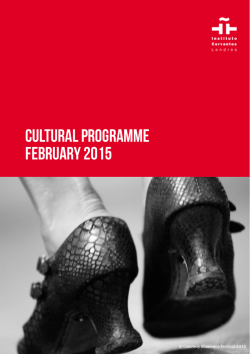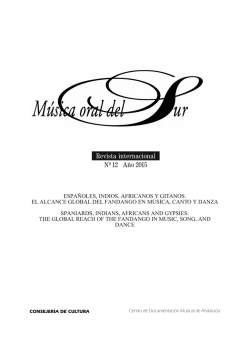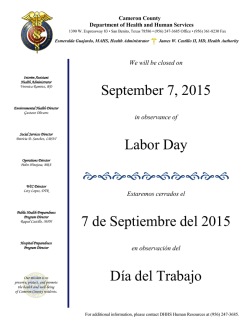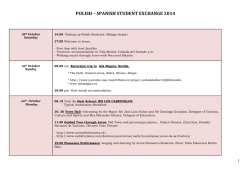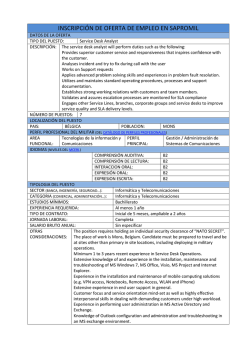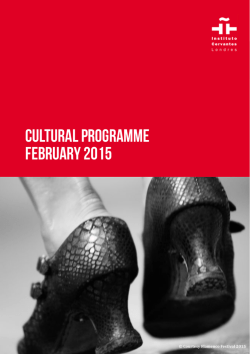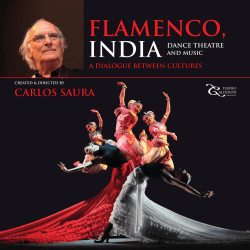
Revista internacional Nº 12 Año 2015
Revista internacional Nº 12 Año 2015 ESPAÑOLES, INDIOS, AFRICANOS Y GITANOS. EL ALCANCE GLOBAL DEL FANDANGO EN MÚSICA, CANTO Y DANZA SPANIARDS, INDIANS, AFRICANS AND GYPSIES: THE GLOBAL REACH OF THE FANDANGO IN MUSIC, SONG, AND DANCE CONSEJERÍA DE CULTURA Centro de Documentación Musical de Andalucía Actas del congreso internacional organizado por The Foundation for Iberian Music, The Graduate Center, The City University of New York el 17 y 18 de abril del 2015 Proceedings from the international conference organized and held at The Foundation for Iberian Music, The Graduate Center, The City University of New York, on April 17 and 18, 2015 Depósito Legal: GR487/95 I.S.S.N.: 11388579 Edita © JUNTA DE ANDALUCÍA. Consejería de Cultura. Centro de Documentación Musical de Andalucía Carrera del Darro, 29 18010 Granada [email protected] www.centrodedocumentacionmusicaldeandalucia.es Facebook: http://www.facebook.com/DocumentacionMusicalAndalucia Twitter: http://twitter.com/CDMAndalucia 2 MÚSICA ORAL DEL SUR, Nº 12, Año 2015 ISSN 11388579 Centro de Documentación Musical de Andalucía Música Oral del Sur es una revista internacional dedicada a la música de transmisión oral, desde el ámbito de la antropología cultural aplicada a la música y tendiendo puentes desde la música de tradición oral a otras manifestaciones artísticas y contemporáneas. Dirigida a musicólogos, investigadores sociales y culturales y en general al público con interés en estos temas. Presidente ROSA AGUILAR RIVERO Director REYNALDO FERNÁNDEZ MANZANO Coordinación K. MEIRA GOLDBERG ANTONI PIZÀ Presidente del Consejo Asesor JOSÉ ANTONIO GONZÁLEZ ALCANTUD Consejo Asesor MARINA ALONSO (Fonoteca del Museo Nacional de Antropología. INAH – Mexico DF) ANTONIO ÁLVAREZ CAÑIBANO (Dir. del C. de Documentación de la Música y la Danza, INAEM) SERGIO BONANZINGA (Universidad de Palermo Italia) EMILIO CASARES RODICIO (Universidad Complutense de Madrid) TERESA CATALÁN (Conservatorio Superior de Música de Madrid) MANUELA CORTÉS GARCÍA (Universidad de Granada) Ma ENCINA CORTIZA RODRÍGUEZ (Universidad de Oviedo) FRANCISCO J. GIMÉNEZ RODRÍGUEZ (Universidad de Granada) ALBERTO GONZÁLEZ TROYANO (Universidad de Sevilla) ELSA GUGGINO (Universidad de Palermo – Italia) SAMIRA KADIRI (Directora de la Casa de la Cultura de Tetuán – Marruecos) CARMELO LISÓN TOLOSANA (Real Academia de Ciencias Morales y Políticas – Madrid) BEGOÑA LOLO (Dirª. del Centro Superior de Investigación y Promoción de la Música, U. A. de Madrid) JOSÉ LÓPEZ CALO (Universidad de Santiago de Compostela) JOAQUÍN LÓPEZ GONZÁLEZ (Director Cátedra Manuel de Falla, Universidad de Granada) MARISA MANCHADO TORRES (Conservatorio Teresa Berganza, Madrid) TOMÁS MARCO (Academia de Bellas Artes de San Fernando – Madrid) JAVIER MARÍN LOPEZ (Universidad de Jaén) JOSEP MARTÍ (Consell Superior d ́Investigacions Científiques – Barcelona) MANUEL MARTÍN MARTÍN (Cátedra de flamencología de Cádiz) MÚSICA ORAL DEL SUR, Nº 12, Año 2015 ISSN 11388579 Centro de Documentación Musical de Andalucía 3 ANTONIO MARTÍN MORENO (Universidad de Granada) ÁNGEL MEDINA (Universidad de Oviedo) MOHAMED METALSI (Instituto del Mundo Árabe – París) CORAL MORALES VILLAR (Universidad de Jaén) MOCHOS MORFAKIDIS FILACTOS (Pdte. Centros Estudios Bizantinos Neogriegos y Chipriotas) DIANA PÉREZ CUSTODIO (Conservatorio Superior de Música de Málaga) ANTONI PIZA (Foundation for Iberian Music, CUNY Graduate Center, New York) MANUEL RÍOS RUÍZ (Cátedra de flamencología de Jeréz de la Frontera) ROSA MARÍA RODRÍGUEZ HERNÁNDEZ (Codirectora revista Itamar, Valencia) SUSANA SARDO (University of Aveiro) JOSÉ MARÍA SÁNCHEZ VERDÚ (RobertSchumannMusikhochschule, Dusseldorf) FRÉDERIC SAUMADE (Universidad de Provence AixMarseille – Francia) RAMÓN SOBRINO (Universidad de Oviedo) Ma JOSÉ DE LA TORREMOLINA (Universidad de Málaga) Secretaria del Consejo de Redacción MARTA CURESES DE LA VEGA (Universidad de Oviedo) Secretaría Técnica MARÍA JOSÉ FERNÁNDEZ GONZÁLEZ (Centro de Documentación Musical de Andalucía) IGNACIO JOSÉ LIZARÁN RUS (Centro de Documentación Musical de Andalucía) Maquetación ALEJANDRO PALMA GARCÍA Acceso a los textos completos Web Centro de Documentación Musical de Andalucía http://www.centrodedocumentacionmusicaldeandalucia.es/opencms/documentacion/revistas Repositorio de la Biblioteca Virtual de Andalucía http://www.bibliotecavirtualdeandalucia.es/catalogo 4 MÚSICA ORAL DEL SUR, Nº 12, Año 2015 ISSN 11388579 Centro de Documentación Musical de Andalucía FANDANGO IN THE FRANCO ERA: THE POLITICS OF CLASSIFICATION Theresa Goldbach University of California, Riverside Resumen: El fandango en la época de Franco: las políticas de clasificación El fandango ha ocupado un lugar muy precario en el panteón de los palos flamencos durante la dictadura de Franco. Mientras que el flamenco se alejaba de la ópera flamenca, de la que los fandangos y los fandanguillos eran emblemáticos, discursos sobre la pureza y el impulso de proyectos de clasificación conllevaron a la ordenación de los palos en flamenco gitano y formas populares. En los primeros tiempos del franquismo, la censura escudriñó las formas populares por laxitud moral o influencias extranjeras. Las nuevas campañas turísticas del gobierno franquista buscaban formas nacionalistas y artes locales que patrocinar. Este artículo examina la trayectoria del fandango en la campaña turística “Festivales de España”, de los años cincuenta y sesenta. Además, analiza cómo las raíces folclóricas del fandango funcionaban como puente entre el uso del imaginario andaluz por parte del gobierno, con fines turísticos, y la ortodoxia de puristas flamencos. Este trabajo considera también la importancia de especialistas como Paco Toronjo para asegurar la supervivencia del fandango como parte del canon flamenco. Palabras Clave: nacionalflamenquismo, ópera flamenca, Franco, “Festivales de España” Fandango en la era de Franco: La clasificación politica. Abstract The fandango occupied a precarious position in the pantheon of flamenco rhythms during the Franco dictatorship. Flamenco was transitioning from the theatrical flamenco and the ópera flamenca era, of which the fandangos and fandanguillos were seen as symbols for many purists. The era referred to as nacionalflamenquismo began as ópera flamenca ended, and an authoritarian dictatorship brought its love of categories and classification. A renewed government tourism campaign searched for nationalist forms and local arts to sponsor. I will examine the trajectory of the fandango through the government sponsored “Festivales de España” campaign in the fifties and sixties. I will analyze how its roots as folk rhythm and flamenco palo provided a bridge between the franquista use of Andalusian imagery for tourist purposes and the orthodoxy of flamenco purists like Antonio Mairena. I will also consider the importance of fandango specialists like Paco Toronjo in assuring its survival as part of the flamenco canon. MÚSICA ORAL DEL SUR, Nº 12, Año 2015 ISSN 11388579 Centro de Documentación Musical de Andalucía 491 THERESA GOLDBACH Keywords: nacionalflamenquismo, ópera flamenca, Franco, “Festivales de España” Author Bio Theresa Goldbach is currently working on a PhD in Critical Dance Studies at the University of California at Riverside. Goldbach is originally from San Antonio, Texas where she studied ballet, Mexican folklore, flamenco, and Spanish classical dance. She has performed with Fandango San Antonio, Ballet Folklorico de San Antonio, Rumba Brava, Estampa Española, and Viva Flamenco. Goldbach attended the University of Texas at Austin as a National Merit Scholar graduating with a Bachelor of Science degree in RadioTVFilm in 1999. After graduation, she studied flamenco at the Amor de Dios studio in Madrid, Spain in 2001. She graduated from the University of New Mexico's Master's program in Dance History in 2014. Goldbach conducted most of the research for her Master's thesis, “Fascism, Flamenco, and Ballet Español: Nacionalflamenquismo,” in the Archivo General de la Administración in Alcalá de Henares, Spain. Her research interests include flamenco and Spanish dance during the reign of General Francisco Franco, politics and dance, and bar culture. Goldbach, Theresa. "Fandango in the Franco Era: The Politics of Classification". Música Oral del Sur, n. 12, pp. 491497, 2015, ISSN 11388579 The fandango occupied a precarious position in the pantheon of flamenco rhythms during the dictatorship of Francisco Franco in Spain from 1936 to 1975. As flamenco transitioned from the theatrical flamenco and ópera flamenca era, of which the fandangos and fandanguillos were emblematic, discourses of purity and classificatory projects sorted palos (rhythms) into flamenco or gitano (Gypsy) and popular or folk forms. Early franquista censorship scrutinized popular forms for potential moral laxity or nonSpanish content. The subsequent franquista government tourism campaign searched for nationalist forms and local arts to sponsor. I will examine the trajectory of the fandango through the government sponsored “Festivales de España” campaign in the fifties and sixties. I will analyze how its roots as folk rhythm and flamenco palo provided a bridge between the franquista use of Andalusian imagery for tourist purposes and the orthodoxy of flamenco purists. I will also consider the importance of fandango specialists like Paco Toronjo in assuring its survival as part of the flamenco canon. As a foundational act, the Franco regime in set up a rudimentary system of censorship in 1937. A law on April 22, 1938 refined this system (Payne 1987: 181). Censorship laws revolved primarily around strict control of the press and promotion of propaganda. Themes of nationalism and xenophobia initially guided the propaganda 492 MÚSICA ORAL DEL SUR, Nº 12, Año 2015 ISSN 11388579 Centro de Documentación Musical de Andalucía FANDANGO IN THE FRANCO ERA: THE POLITICS OF CLASSIFICATION strategy of early franquista censorship as much as the religious based morality of later eras. Stanley Payne cites the example of the required addition of an “e” at the end of the word “restaurant” in Spain to differentiate it from the French and English spelling of the word to demonstrate this strategy (188). Another example employed by Payne is the legislation passed in 1938 “requiring that all newly christened Spanish children receive appropriate Spanish names not identified with foreign cultures or religions” (188). Satire and musical comedy particularly concerned the censors, who considered these potentially dangerous forms. A November 1940 letter by the head of the national Theatre Department to a local censor, Manuel Sanz from Castellón de la Plana, attempts to provide “requested clarification” as to what constitutes musical comedies as they “have special regulations” (“Letter from the National Chief of the Department of Theatre to the Provincial Chief of Propaganda of Castellón de la Plana (Manuel Sanz) on 7 Nov 1940”).1) Per censorship regulations, all theatrical shows needed a censorship paper (hoja de censura) that should be presented upon request to the local censor (per Circular quoted in the letter). In addition to the censorship paper, musical comedies also needed to have extra documentation and corresponding registration not only with the Section of Censorship but also with the Society of Authors and Companies (“Circular of 24 March 1940”). The Chief wrote to Señor Sanz that: [T]he measures to which the circular of the past 24 of April refers, are only applicable to shows technically known as musical comedies that should not be confused with the operettas or zarzuelas of a certain level that in any case exempt the genre from review when it is developed with the needed dignity. (“Letter from the National Chief of the Department of Theatre to the Provincial Chief of Propaganda of Castellón de la Plana (Manuel Sanz) on 7 Nov 1940”) By declaring the potential “dignity” of zarzuela, the Chief of the Department articulates the implied hierarchy that places escuela bolera and zarzuela (native Spanish “classical” forms) on a higher moral as well as cultural level than the popular entertainments derived from “foreign” sources such as the American Vaudeville or Hollywood musical comedies.2) Another bulletin (from September 1940) further illustrates the association of Vaudeville (or vodevil) with questionable morals stating that: “With these [extra] measures, the Department of Theatre is trying to stimulate the substitution of the vodevil [sic] genre by shows of an analogous structure, but of a certain moral level” (“Bulletin Number 193 of the Spanish General Society of Show Impresarios Sept 1940”). Vaudeville represented not only a foreign threat to Spanish nationalism but also a moral threat to Spanish Catholicism. 1) All translations from Spanish by Theresa Goldbach unless otherwise noted in citation. Despite the strict Hays code enforced in Hollywood at the time, many American movies and movie stars (such as Bette Davis, Joan Crawford, Paul Robeson, Burgess Meredith, and James Cagney) were considered too scandalous for Spanish audiences and their films were banned from presentation in Spain (“List of Banned Artists” Box 21/50). 2) MÚSICA ORAL DEL SUR, Nº 12, Año 2015 ISSN 11388579 Centro de Documentación Musical de Andalucía 493 THERESA GOLDBACH In this alignment, the forms of fandangos popularized in the ópera flamenca genre would have had an advantage over American music and dance. The perceived “Spanishness” of the fandangos and other flamenco or Spanish folk forms allowed them to escape the xenophobic scrutiny. In addition, their “Spanishness” also lent an aura of “tradition” to the forms that would have appealed to the conservative sensibilities of censors and bureaucrats. As early franquismo segued into National Catholicism (19431951), censorship became more standardized, though not necessarily eased. Reports from provincial censors no longer arrived in terse telegrams (per records in (3)49.1 21/45 and 21/46 dated March November 1942). Instead reports from all provinces arrived once per annual quarter and were divided into three sections by genre: Theatrical Shows, Variety Shows, and Films (per records in (3)49.1 21/2341, 21/2003, and 21/2334 dated 19481951). Escuela bolera and zarzuela usually came under the heading of “Theatrical Shows” while flamenco performances typically fell into the category of “Variety Shows” unless performed in a mixed program with Spanish Classical and other Spanish forms. The variety show format required individual listing of the names and titles (dancer, singer, musician, etc.) of all performers, of each musical number, and the names of composers. The sheet music and lyrics needed to be preapproved as well. For flamenco performances, the composer was normally listed as either “traditional” or the name of the singer or musician performing the piece. Over time, a few evolutions took place in the way that flamenco performers were classified. First, flamenco dancers and singers moved from the generic Spanish classifications of bailarín or bailarina (for dancer) and cantante (for singer) to terminology more specifically associated with flamenco: bailaor or bailaora and cantaor or cantaora. This shift signified recognition of a fundamental difference in flamenco that set it apart from other popular “Variety Show” genres. Other terms joined the list as well: baile flamenco (flamenco dance), cancion andaluza (Andalusian singing), cancion flamenco (flamenco song), baile gitano (Gypsy dance), cante gitano (Gypsy Song), cante jondo (deep song), and baile jondo (deep dance). From the documents, it is unclear whether or not the terms baile gitano or cante gitano referred only to Gitano performers or to anyone performing flamenco. Also, the use of these terms is notable for three reasons: 1) because the jondo designation does not refer to all of the flamenco family of song, 2) the labels are used even when the program includes nonjondo palos,3) 3) the appellation baile jondo was not as commonly used in flamenco scholarship or colloquial terminology as the more typical term cante jondo. Concurrent with this incorporation of exclusively flamenco terminology, a trend towards exempting flamenco performers from the extra scrutiny of 3) It may be that certain performers would only perform jondo numbers as sometimes the cante or baile jondo appellation would be used in the same roster as bailarina or cancion andaluza. This is not clarified in any of the documents. 494 MÚSICA ORAL DEL SUR, Nº 12, Año 2015 ISSN 11388579 Centro de Documentación Musical de Andalucía FANDANGO IN THE FRANCO ERA: THE POLITICS OF CLASSIFICATION lyrics and music occurred. As in the report from the province of Valladolid dated 9 October 1950, the listing for the Compañía de Raimundo Blu contains a roster of performers (using the term cancion flamenco),4) such as guitarist Antonio Reyes, but a list of musical numbers in the performance is omitted (“Report from Valladolid 9 October 1950”). In contrast an earlier listing from the same province of the company of Juanito Valderrama not only fails to use the flamenco terminology but also requires a listing of the individual numbers, which included a pasodoble, albeit with a note saying that the “libretto” has previously been seen by the Inspector (“Report from Valladolid 67 May 1950”). Besides flamenco, the other performances labeled as “Variety Shows” tended to include LatinAmerican styles (Cuban, Mexican boleros), American swing, jazz or popular music, and Spanish popular music. As with the fandangos, certain palos like the garrotín, pasodoble, malagueña, and sevillanas migrated between the Spanish popular genre and flamenco. However, for performers whose repertory revolved around Latin American or American (especially swing or jazz) styles, additional scrutiny was consistently applied. It would appear that at the time it was more convenient to be categorized as a flamenco performer than as a performer of other “Variety Show” genres. With the influx of international tourists in Spain in the 1950s, more social and cultural influences from foreign countries did enter Spain. The United States formally re established diplomatic relations with Spain through the Pact of Madrid signed in 1953 (Payne 1987: 418). Throughout the next decade, the Ministry of Information and Tourism began to shift some resources to the marketing of Spain to the rest of the world and away from the policing of popular entertainments. Sasha Pack suggests that the Spanish propaganda machine advertised the surge of tourists to Spain back to the Spanish population in an effort to foster an image of prosperity despite a still struggling economy (Pack 2010: 53). The structure of censorship had evolved from a volunteer force of political believers to a web of career bureaucrats by the end of the 1950s (“Proposals for the Remuneration of the Inspector Personnel” 19591960, Box 42860). One major nexus of the tourism and propaganda imperatives was the campaign of festivals known as the “Festivales de España”. Each festival on the official calendar featured various ciclos or “cycles”: music, theatre, dance, and Ballet Español. The Ballet Español genre grew out of the move of flamenco from cafés and parties to the concert stage, prompted by dancers trained in classical Spanish forms. These artists formed companies and toured internationally, supplementing the flamenco repertoire with classical Spanish pieces, escuela bolera, Spanish folk dance (especially jota from northern Spain), and even folk dances from Mexico and South America.5) The use of the French word “ballet” emphasizes 4) The document actually reads “cnacion” but that is an obvious typographical error (21/2003). 5) La Argentinita’s company performed the Baile de los viejitos from Michoacán as well as folk dances from Perú as part of their repertoire while on tour in the United States. MÚSICA ORAL DEL SUR, Nº 12, Año 2015 ISSN 11388579 Centro de Documentación Musical de Andalucía 495 THERESA GOLDBACH a cultural aspiration towards classicism and high culture and also the presence of a corps de ballet. The term Ballet Español was most associated with dancer Pilar López and her company, her name occasionally serving as a synonym for the term in government documents. The inclusion of this flexible category of Spanishness in motion in the festival campaign allowed for the incorporation of seemingly diverse forms under the mantle of Spanish dance hegemony. In the region of Andalucía, an additional cycle supplemented the local festival circuit typically referred to as “Baile y Cante Andaluz” or “Cantes y Bailes Andaluces.” As standard for the format, the “Baile y Cante Andaluz” from the Festivales de España’s 1954 Sevilla series included in its program a cuadro of sevillanas and a section of fandangos performed by Paco Isidro, “El Cojo de Huelva”, and el Piripi. The performance progressed through bulerias (featuring La Paquera de Jerez, Terremoto, Paco Laberinto, and Moraito) and soleares (featuring Fernanda and Bernarda de Utrera). After a section of alegrías that included mirabras, serranas, and verdiales, the show culminated with seguiriyas and martinete lead by Antonio Mairena. The next year the lineup retained much of the same structure beginning with different styles of sevillanas. The fandangos section that year featured singers the “Hermanos Toronjo” as the cantaor Paco Toronjo built his name as an expert in interpreting forms of fandangos (“Program from ‘Cante y Baile Andalucía’ Festival Internacional de Sevilla 1955.” (3)49.9 38169). In the Ballet Español shows by the large companies of Pilar López, Antonio “el Bailarín”, “Mariemma”, and Luisillo, fandangos were typically grouped in with the flamenco portions of performances, as opposed to folk or classical portions. A 1955 performance by Antonio’s company ended the flamenco part of the show with a fandangos por verdiales by Antonio and the company. Several 1957 performances by the company retained this number as finale after the cuadro flamenco section ((3)49.9 38169). By 1966, the official Festival calendar lasted from April through October, included sixty four festivals, homages, and certamenes or contests, and took place in sixty different cities and towns across Spain (“Plan nacional de Festivales de España 1966” (3)49.9 38124). The early stirrings of the Flamenco Renaissance and the rise of flamencology shifted flamenco preferences away from more popular forms in favor of forms like the solea and siguiriya. However, fandangos did not fade into temporary obscurity as other palos did. The seventies Rito y geografía del cante documentary series even devoted an entire episode to the palo. So, why did the fandangos survive in the flamenco canon? There are many potential reasons for this. One possibility is the existence of the more flamenco iterations of the fandangos appellation (sometimes called naturales) that are not danced. Since much flamenco discourse, both popular and academic, implicitly equated dance with the inauthentic already one step removed from the real flamenco, the fandangos naturales met the prevalent standards for purity. Another reason could be the appeal of the multiple geographic forms of the fandangos for flamenco structuralists seeking to organize 496 MÚSICA ORAL DEL SUR, Nº 12, Año 2015 ISSN 11388579 Centro de Documentación Musical de Andalucía FANDANGO IN THE FRANCO ERA: THE POLITICS OF CLASSIFICATION flamenco geography and rhythmography. The presence of fandangos in both folk and flamenco traditions could provide fodder for anyone seeking to prove the dominance of Andalusian folk forms in foundations of flamenco. Perhaps more importantly, however, the flamenco fandangos were blessed with an advocate and specialist in the person of Paco Toronjo. The organizers of flamenco shows (whether government bureaucrats or flamenco aficionados) would be more inclined to include performers who were already known to flamenco audiences. As proven by Toronjo’s inclusion in previous government sponsored performances, bureaucrats were familiar with the singer’s work as were general audiences. While trends in flamencology definitely influenced and guided the Flamenco Renaissance of the sixties and seventies, flamenco does not live by scholarship alone. It is the performers who are ultimately responsible for the content of their performances. Perhaps because of all of these reasons, the fandangos survived the paradigm shift of the Flamenco Renaissance. MÚSICA ORAL DEL SUR, Nº 12, Año 2015 ISSN 11388579 Centro de Documentación Musical de Andalucía 497 THERESA GOLDBACH 498 MÚSICA ORAL DEL SUR, Nº 12, Año 2015 ISSN 11388579 Centro de Documentación Musical de Andalucía
© Copyright 2026
